
Jean-Hippolyte Flandrin was a French Neoclassical painter. His most celebrated work, Jeune Homme Nu Assis au Bord de la Mer (1836) is held in the Louvre.
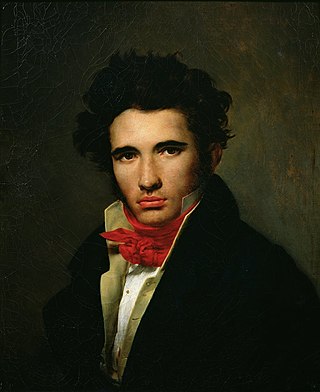
Léon Cogniet was a French history and portrait painter. He is probably best remembered as a teacher, with more than one hundred notable students.

A festoon is a wreath or garland hanging from two points, and in architecture typically a carved ornament depicting conventional arrangement of flowers, foliage or fruit bound together and suspended by ribbons. The motif is sometimes known as a swag when depicting fabric or linen.
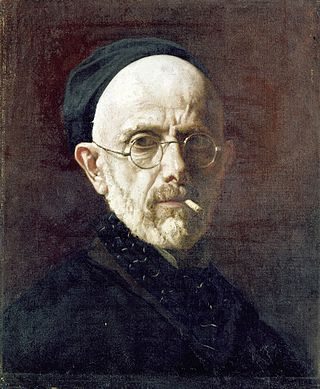
Henri Lehmann was a German-born French historical painter and portraitist.
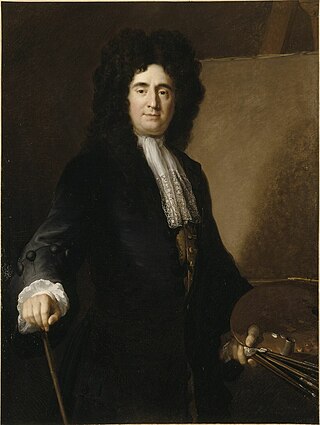
François de Troy was a French painter and engraver who became principal painter to King James II in exile at Saint-Germain-en-Laye and Director of the Académie Royale de peinture et de sculpture.

The Église Saint-Augustin de Paris is a Catholic church located at 46 boulevard Malesherbes in the 8th arrondissement of Paris. The church was built between 1860 and 1871 by the Paris city chief architect Victor Baltard. It was the first church in Paris to combine a cast-iron frame, fully visible, with stone construction. It was designed to provide a prominent landmark at the junction of two new boulevards built during Haussmann's renovation of Paris under Napoleon III. The closest métro station is Saint-Augustin

Eugène Emmanuel Amaury Pineux Duval, better known by the pseudonym Amaury-Duval, was a French painter. He was one of two sons of Amaury Duval (1760–1838) and thus a nephew of the playwright Alexandre-Vincent Pineux Duval.

Jacques d'Agar was a French portrait painter born in Paris. He was a pupil of Jacob Ferdinand Voet. He began his career as a history painter, but soon abandoned it for portraiture, a branch of art in which he became very successful.

Alexandre Ubeleski was a French painter. Ubeleski was born in Paris in 1649. He was a pupil of Charles Lebrun, and completed his studies in Rome, where he became a member of the Academy, and where he painted the dome of a chapel in Santa Maria in Transpontina.
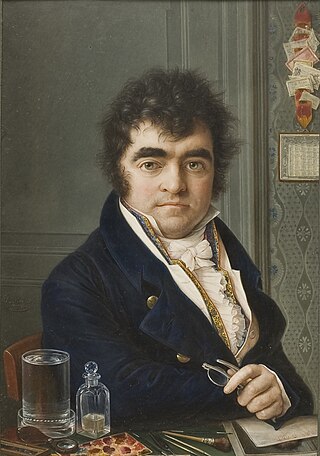
Louis-Marie Autissier, was a French-born portrait miniature painter in the Netherlands. According to Marjorie E. Wieseman, curator of European painting, at the Cincinnati Art Museum, "Autissier's success as a miniaturist was in large measure due to his talent as a colourist and his meticulous detailing of costumes and accessory." He is considered the founder of the Belgian school of miniature painting in the nineteenth century. Among his most accomplished pupils and followers were Alexandre de Latour a (1780–1858), Louis Henri de Fontenay, and Dominique Ducaju (1802–1867) b. His works are in the collections of the Cincinnati Art Museum, the Nationalmuseum and the Royal Collection.

Hendrik Scheffer was a Dutch painter in the Romantic tradition who lived in France for most of his life. In France he is usually known as Henri Scheffer.

Antoine Chazal was a French painter of flowers and of portraits, as well as an engraver. He studied under Misbach, Bidauld, and Van Spaendonck, and became Professor of Iconography at the Jardin des Plantes. Besides portraits, flowers, and fruit, he painted a few landscapes and altar-pieces for churches. He also engraved a portrait of Cardinal La Fare. Chazal died in Paris in 1854.

François Barthélemy Michel Édouard Cibot (1799–1877) was a French historical and landscape painter born in Paris. His masters were Guérin and Picot. During the first part of his career he devoted himself to historical painting, producing many sacred works, several specimens of which are to be seen in the churches of Paris. His most important work of this kind is the series of paintings representing Charity, in the church of St. Leu at Paris. About 1863 he applied himself to landscape painting. He died in Paris in 1877. Amongst his best works are:

Alexandre-Marie Colin was a French painter of historical and genre subjects.

Sébastien-Melchior Cornu was a French painter, specializing in religious works and portraits.

Charles-Alexandre Debacq was a French historical and portrait painter. He became a pupil of Gros, and was greatly appreciated in his own country. There are several pictures by him at Versailles.
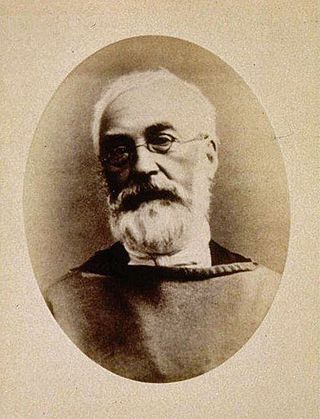
Louis Charles Auguste Steinheil was a French painter.

Alexandre Desgoffe (1805–1882) was a French landscape painter born in Paris. He studied under Ingres, and travelled in Italy from 1837 to 1842. He usually introduced into his landscapes historical or mythological incidents, and he also painted some Biblical subjects. The Luxembourg Gallery has his Fury of Orestes, and the Museum of Lyons his Cyclops. He decorated the Salle des Etudes of the Bibliothèque Nationale in 1868. He died in Paris in 1882.

Charles-Dominique-Joseph Eisen was a French painter and engraver.

Émile Boeswillwald was a French architect. He succeeded Prosper Mérimée as Inspector General of Historic Monuments and collaborated with Eugène Viollet-le-Duc.



















